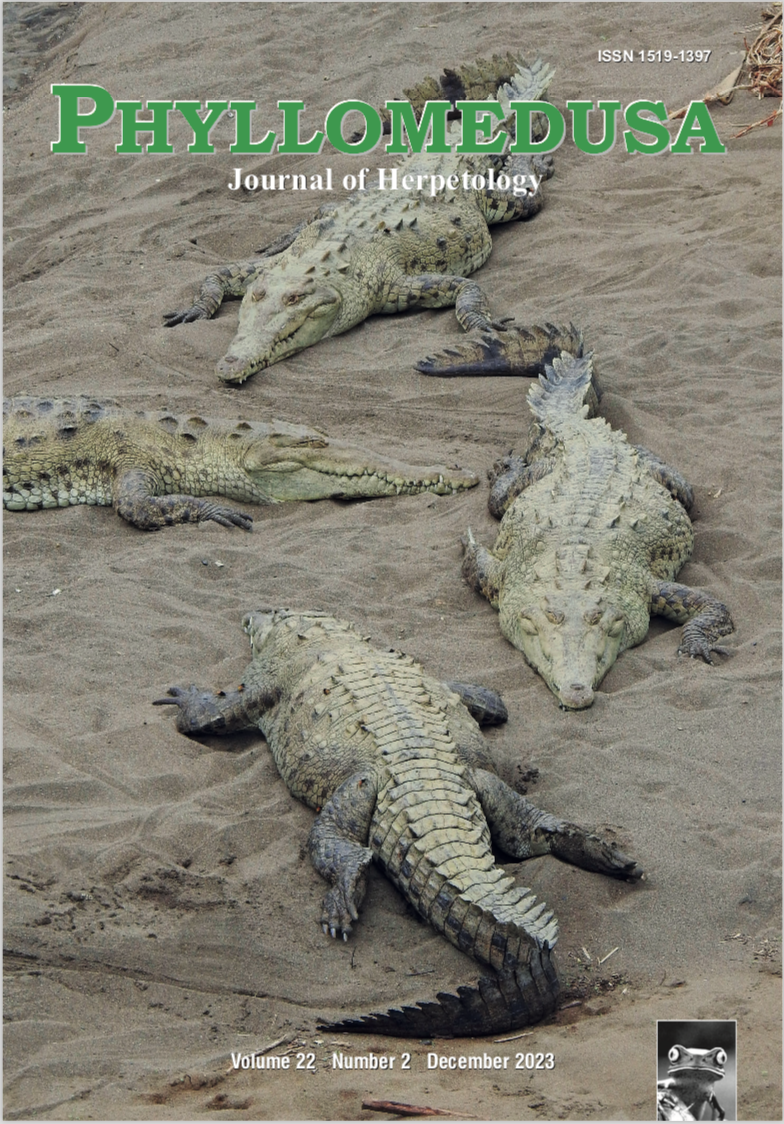Notes on facultative use of bat-modified “leaf tents” by Agalychnis Red-eyed treefrogs (Anura: Hylidae)
DOI:
https://doi.org/10.11606/issn.2316-9079.v22i2p195-201Keywords:
Diurnal retreat, Natural history, Oviposition, Phyllomedusinae, PhyllostomidaeDownloads
References
Blaustein, A. R. and J. M. Kiesecker. 2002. Complexity in conservation: Lessons from the global decline of amphibian populations. Ecology Letters 5:597–608.
Boinski, S. and R. M. Timm. 1985. Predation by squirrel monkeys and double-toothed kites on tent-making bats. American Journal of Primatology 9:121–127.
Cruz, C. A. G. 1990. Sobre as relações intergenéricas de Phyllomedusinae da Floresta Atlântica (Amphibia, Anura, Hylidae). Revista Brasileira de Biologia 50: 709–726.
Duellman, W. E. 1970. Hylid frogs of Middle America. Monograph of the Museum of Natural History, University of Kansas 1: 1–753.
Duellman, W. E. and L. Trueb. 1986. Biology of Amphibians. New York. McGrawHill. 669 pp.
Faivovich, J., C. F. B. Haddad, D. Baeta, K-H. Jungfer, G. F. R. Álvares, R. A. Brandão, C. Sheil, L. S. Barrientos, C. L. Barrio-Amorós, C. A. G. Cruz, and W. C. Wheeler. 2010. The phylogenetic relationships of the charismatic poster frogs, Phyllomedusinae (Anura, Hylidae). Cladistics 26: 227–261.
Faivovich, J., M. O. Pereyra, M. C. Luna, A. Hertz, B. Blotto, C. R. Vásquez-Almazán, J. R. McCranie, D. Sanchez-Ramirez, D. Baêta, K. Araujo-Vieira, G. Köhler, B. Kubicki, J. A. Campbell, D. R. Frost, and C. F. B. Haddad. 2018. The monophyly and relationships of several genera of Hylinae (Anura: Hylidae: Hylinae) with comments on recent taxonomic changes in hylids. South American Journal of Herpetology 13: 1–32.
Gautam, B. and S. Bhattarai. 2020. Frugivory by the tadpoles of Terai tree frog Polypedates teraiensis (Dubois, 1987) from Nepal. Journal of Animal Diversity 2: 42–45.
Gosner, K. L. 1960. A simplifed table for staging anuran embryos and larvae with notes on identifcation. Herpetologica 16: 183–190.
Jacobs, D. S. and A. Bastian. 2016. Co-evolution between bats and frogs? Pp. 89–106 in D. S. Jacobs and A. Bastian (eds.), Predator-Prey Interactions: Co-evolution Between Bats and Their Prey. Cham. Springer. Nunes, I. and F. R. Costa. 2011. “Hide and seek”: diurnal refuge and camoufage of two anurans from the Atlantic Forest of Northern Brazil. Herpetology Notes 4: 431–433.
Pyburn, W. F. 1963. Observations on the life history of the tree frog Phyllomedusa callidryas (Cope). Texas Journal of Science 15: 155–170.
Pyburn, W. F. 1970. Breeding behavior of the leaf-frogs Phyllomedusa callidryas and Phyllomedusa dacnicolor in Mexico. Copeia 1970: 209–218.
Pyburn, W. F. 1980. The function of the eggless capsules and leaf in nests of the frog Phyllomedusa hypochondrialis (Anura: Hylidae). Proceedings of the Biological Society of Washington 93: 153–167.
Rodríguez-Herrera, B., R. A. Medellín, and M. Gamba-Ríos. 2008. Roosting requirements of White tent-making bat Ectophylla alba (Chiroptera: Phyllostomidae). Acta Chiropterologica 10: 89–95.
Rodríguez-Herrera, B., R. A. Medellín, and R. M. Timm. 2007. Neotropical Tent-Roosting Bats. Heredia. Editorial INBio. 178 pp. Rodríguez-Herrera, B., M. E. Rodríguez, and M. F. Otárola. 2018. Ecological networks between tent-roosting bats (Phyllostomidae: Stenodermatinae) and the plants used in a Neotropical rainforest. Acta Chiropterologica 20: 139–145.
Rodríguez-Herrera, B., L. Víquez-R., E. Cordero-Schimdt, J. M. Sandoval, and A. Rodríguez-Durán. 2016. Energetics of tent roosting in bats: The case of Ectophylla alba and Uroderma bilobatum (Chiroptera: Phyllostomidae). Journal of Mammalogy 97: 246–252.
Roznik, E. A. and S. A. Johnson. 2009. Burrow use and survival of newly metamorphosed gopher frogs (Rana capito). Journal of Herpetology 43: 431–437.
Salazar-Zúñiga, J. A., W. Chaves-Acuña, G. Chaves, A. Acuña, J. I. Abarca-Odio, J. Lobón, and F. Bolaños. 2019. The most frog-diverse place in Middle America, with notes on conservation status of six threatened species of amphibians. Amphibian & Reptile Conservation 13: 304–322.
Simioni, F., V. A. Campos, T. F. Dorado-Rodrigues, J. Penha, and C. Strüssmann. 2014. Crab burrows and termite thermal chimneys as refuges for anurans in a Neotropical wetland. Salamandra 50: 133–138.
Strüssmann, C. and I. Sazima. 1991. Phrynohyas hebes (NCN). Feeding. Herpetological Review 22: 97.
Timm, R. M. and B. L. Clauson. 1990. A roof over their feet: Tent-making bats of the New World tropics turn leaves into living quarters. Natural History 3: 55–60.
Tuttle, M. D. and M. J. Ryan. 1981. Bat predation and the evolution of frog vocalizations in the Neotropics. Science 214: 677–678.
Villalobos-Chaves, D., B. Rodríguez-Herrera, and M. Tschapka. 2013. First records of day roosts of the nectar-feeding bat Lichonycteris obscura (Phyllostomidae: Glossophaginae). Caribbean Journal of Science 47: 335–338.
Warkentin, K. M. 1995. Adaptive plasticity in hatching age: A response to predation risk trade-ofs. Proceedings of the National Academy of Sciences 92: 3507–3510.
Warkentin, K. M. 2000. Environmental and developmental efects on external gill loss in the red-eyed tree frog, Agalychnis callidryas. Physiological and Biochemical Zoology 73: 557–565.
Wells, K. D. 2007. The Ecology and Behavior of Amphibians. Chicago. University of Chicago Press. 1148 pp.
Downloads
Published
Issue
Section
License
Copyright (c) 2023 ESALQ-USP

This work is licensed under a Creative Commons Attribution-NonCommercial-NoDerivatives 4.0 International License.
All material originally published in Phyllomedusa belongs to Escola Superior de Agricultura Luiz de Queiroz - Universidade de São Paulo. All contents are under a license of Creative Commons BY-NC-ND.


 Impact Factor (JCR): 0.600
Impact Factor (JCR): 0.600 CiteScore: 1.0
CiteScore: 1.0